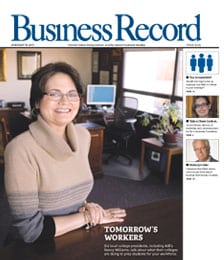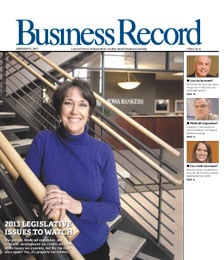Employees bearing more of the health insurance burden

In today’s world of rising health-care costs and health insurance premiums, perhaps no one feels the effects more than small business owners.
A few have gone so far as to throw up their hands and eliminate health insurance from their list of employee benefits. Far more, however, have revisited their company-sponsored plans and taken a strategic approach with a variety of health insurance options intended to encourage overall wellness and responsible health-care spending among their workers.
“In my opinion, options for the small business – with consumer-driven health care and health spending accounts – are greater than they ever have been,” said Steve Flood, senior vice president of Holmes Murphy & Associates Inc., a West Des Moines-based benefits brokerage.
Company-sponsored health insurance plans originated during World War II as a way for businesses to attract employees during a government-imposed salary freeze. With minimal costs to employers, company-sponsored health insurance became known as a fringe benefit.
Since then, those benefits have played an increasing role in employee recruitment and retention due to a competitive job market.
“It’s no longer considered a fringe benefit,” said Mark Becker, executive vice president of David P. Lind & Associates. “It is a key component of total compensation, so we can’t treat it like the employee-of-the-month parking spot.”
The added importance has been accompanied by higher costs. Health insurance is now companies’ second largest expense behind payroll, costing employers anywhere from $8,000 to $12,000 per employee annually for family coverage and between $5,000 and $7,000 for single coverage.
In recent years, health insurance costs for employers have risen 13 to 16 percent a year on average. At 15 percent, Becker said, insurance rates will double every five years.
Faced with that reality, small business owners continually cite health insurance among their list of top concerns, realizing they need to provide that benefit to recruit talented workers, but also realizing it may become cost-prohibitive to do so. Some nationwide studies have shown an increase in the number of small business owners dropping health insurance benefits. But Becker said only “a fraction of a percent” of Iowa’s small businesses intend to discontinue coverage.
Both Lind & Associates and Holmes Murphy have encouraged their small to mid-sized clients to consider a variety of health insurance options before throwing in the towel.
“There isn’t a silver bullet,” Becker said of the options available to employers. “There’s an inventory of ammunition.”
The original intent of health insurance was to provide coverage for major health problems, he said. With consumer-driven, high-deductible plans that were popular 20 years ago or more, employees began to pay a greater portion of the costs associated with their health care.
“But with HMOs and low-dollar co-pays, we’ve made it cheaper for people to see the doctor than get a haircut,” Becker said. As a result, employers are faced with a higher number of claims for sometimes unnecessary health-care expenses.
Flood said many small businesses are considering consumer-driven health-care options, particularly health savings accounts, high-deductible health plans or health reimbursement arrangements that make employees more responsible for how their health-care dollars are spent. In those plans, employees become wiser consumers of health care by becoming more vigilant about their health and choosing lower-cost options when it comes to doctors, prescriptions and other types of expenses.
“For a small business, (a health savings account) can offer the ability for the employee to set aside money that they would normally send to their insurance company,” Flood said. “It can accumulate and be used for retirement needs or health-care needs as long as they live.” The account contributions are tax-free. If the money is used for retirement, it’s taxed as regular income when it’s withdrawn, similar to a 401(k) plan.
An HSA provides another option for employers who can’t afford a traditional retirement plan, he said, or for those whose contributions to employees’ 401(k) plans are limited by government restrictions. Employees who put thousands of dollars a year into a HSA can eventually opt for a higher deductible and save hundreds of dollars a month in premiums.
HSAs aren’t for everyone, Becker said, particularly employers who struggle just to pay minimum wage. But for employees with discretionary income, “it might be a great tax shelter and a way to take more accountability into your health.”
That concept of accountability has been the driving force behind these options among small to mid-sized companies. When employees are forced to manage their own health-care dollars, industry experts say, it makes them more responsible stewards of those dollars.
When Owner Revolution Inc. switched insurance carriers due to customer-service concerns, its employees were faced with a higher deductible. To counter that added expense, the Adair-based manufacturer offered a health reimbursement account to its 103 full-time employees, an arrangement that “teaches them responsibility for their own health-care expenses,” said Roberta Beschorner, the company’s vice president of human resources.
Owner Revolution once faced annual health insurance premium increases of 15 to 20 percent, Beschorner said. This year, however, the company’s health insurance costs have stayed flat. As an employee-owned company, Owner Revolution’s workers have developed a greater understanding of how these costs can affect the company’s overall profitability.
“Even being a small company, we can compete with any employer in recruiting with our benefit plans,” Beschorner said.
Though consumer-driven options are now the preferred choice among small and mid-sized companies, some are still considering health insurance pools that bring a few or even dozens of companies together under one health insurance plan.
Flood said most companies that operate under a pooled plan believe they will save money through decreased administrative costs, but “the administrative costs are a small piece of the pie.” About 80 to 85 percent of the costs are tied to claims. The total group cost, therefore, is based on how healthy or unhealthy its members are.
“If your group is very healthy and my group is very sick, do you really want to average our costs and share my burden?” Becker asked. “The only place where groups can pool and save money is if they are, on average, healthier than the average population.”
Becker recently disbanded a group of 40 to 50 small businesses that had pooled together for insurance purposes but had lost significant amounts of money in the process. “On aggregate,” he said, “they’d save 30 percent by not coming together.”
Still other companies choose to compensate their employees by offering, for example, higher wages so they can afford to pay for health insurance on their own or through their spouse’s employer, known as spousal carve-out plans.
“A lot of companies do it,” Flood said, “but it can get messy.”
In working with its clients, Lind & Associates has discouraged the 12-month approach that has become too common among small and mid-sized companies: sign on with a carrier and then switch to a new carrier one year later in the hope of saving money. Instead, Becker advises, look at the situation in a three- to five-year window and set some guidelines on what you want the plan to accomplish and how you will manage it.
“We teach the difference between product and process,” he said. “The process is more important. Too many (businesses) shop the market way too much and they’re too quick to change their product.”







